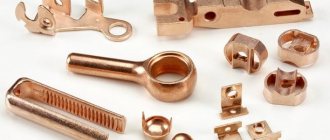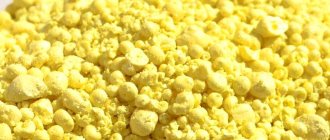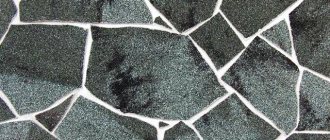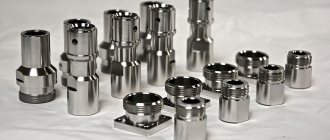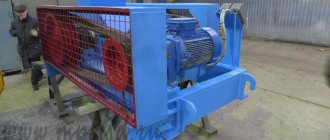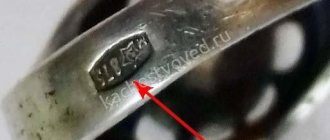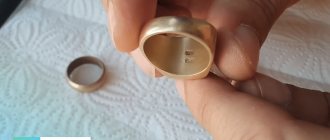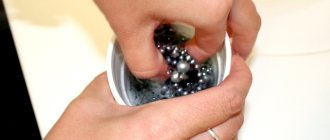Protection of “iron” from corrosion is carried out in several cases: during primary processing, in order to restore damage in a separate area or decorate a sample. In this case, various metals are used - brass, copper, silver and a number of others. Let's look at the technology of nickel plating at home as one of the simplest and most accessible in terms of independent implementation.
In addition, it is also the most common. When covering parts with a protective layer of other metals, the thinnest nickel film plays the role of an intermediate layer. It is advisable to apply it, for example, before chrome plating parts.
Note. There are quite a lot of recipes for the chemicals used. The author considered it correct to cite only those whose effectiveness he personally verified by applying a protective nickel coating at home.
The unit of measurement for components is g/l of water (unless otherwise stated). All chemicals used are diluted separately, carefully filtered and only then mixed to obtain an electrolytic solution.
DIY nickel plating at home
The procedure for coating a surface with nickel involves applying a nickel layer with a thickness of 1 to 50 microns to the part. The layer can be matte or shiny, regardless of this, it will NOT provide reliable protection of the part from the effects of aggressive environments (acidic, alkaline), high temperature, or corrosion. This is a must-have! To achieve protective properties, the coating must be subjected to mandatory post-processing.
An important point in the nickel plating procedure at home is the correct preparation of the workpiece. To do this, it is necessary to remove the oxide film from the product by wiping with sandpaper and then with a brush, then rinse thoroughly under water, degrease in a heated soda solution, and rinse again.
To prevent the occurrence of unpleasant consequences of incomplete preparation when nickel plating at home, metal parts should always be coated with a more or less thick layer of nickel.
Copper, iron, and their alloys are usually used as metals for nickel plating at home. It is strictly not recommended to coat lead, tin, bismuth and antimony. If steel parts are processed, it is customary to apply a copper underlayer.
Handicraft and industrial methods of nickel plating
The widespread use of nickel plating in industrial production is mainly due to the fact that nickel coatings have one of the highest levels of corrosion resistance, and their hardness is higher than that of cadmium, zinc and tin protection.
But nickel is much more expensive than all these metals, so it is most often used in cases where it is necessary to protect products from corrosion and at the same time give it an aesthetic appearance. Externally, nickel coatings are very similar to chrome, but have a warmer tint (see figure below).
Specifics, definition and purpose of nickel plating
Protective nickel coating can be applied to almost all types of metals and their alloys, as well as glass, plastic and ceramics. But most often, nickel plating is used for protective and decorative treatment of products made of steel, copper, zinc, aluminum and their alloys.
At home, products are most often coated with a single nickel layer, but in industrial production, nickel is usually included in multilayer coatings. This is due to its porosity, which completely disappears only when the layer thickness is more than 30 microns.
For this reason, nickel is most often applied to an underlayer of copper, and the outside is protected with layers of chromium or cadmium.
Nickel plating of parts with preliminary copper plating is easy to carry out even in a home workshop, but the use of chromium and cadmium requires special conditions and precautions due to the high toxicity of the compounds of these metals. With industrial and home nickel plating using electrolyte additives and various electrolysis modes, the following types of surfaces can be obtained:
- shiny;
- matte;
- semi-shiny;
- two- and three-layer;
- compositional;
- black;
- velor;
- wear-resistant.
The picture below shows products with matte and black nickel finishes.
“Black” nickel is used in optical instruments and in the creation of military equipment. It contains up to three quarters of non-metallic components - nickel sulfides and zinc hydroxides. It is very difficult to apply such coatings at home, since this requires professional knowledge and special reagents.
Pros and cons of nickel-plated coatings
Nickel is resistant to corrosion in alkalis of any concentration and dissolves very slowly in sulfuric and hydrochloric acids.
In concentrated nitric acid, the nickel coating behaves neutrally and only forms a protective film, but with its aqueous solution it reacts very actively.
All this is important for industrial use, but at home, nickel can be considered passive to all types of reagents.
The main disadvantage of nickel coating, which is associated with the peculiarities of the deposition of this metal, is its porosity, which has a depth of up to 25–30 microns.
Therefore, nickel plating, as a rule, is carried out over a copper sublayer, which is easy to implement even in a home workshop with minimal skills in electroplating. Another way to protect against porosity is to supplement the nickel coating with a protective layer of phosphorus compounds, chromium, etc.
To apply nickel to the surface of aluminum, the product is first subjected to zincate treatment, after which galvanic nickel plating is performed on the zinc surface. Like preliminary copper plating, this technology can be easily implemented even in a home workshop.
Nickel Plating Methods
There are two ways to apply nickel to the surface of metals in active solutions: galvanic (using a current source and a nickel anode) and chemical (by deposition in a solution of nickel salts).
Electroplating nickel plating has a higher speed and allows you to obtain nickel layers on the surface of the product that have greater hardness and less porosity. With chemical nickel plating, the metal layer is looser and more elastic.
This technology is popular among home DIYers because it is very easy to implement and requires a minimum of reagents.
Electrolytic method
Electrolysis coating of products with a nickel layer is carried out using traditional technology. The workpiece, which acts as a cathode, and an anode made of pure nickel are placed in a container with electrolyte.
When a positive voltage is applied to the anode and a negative voltage to the product, an electrochemical process begins, as a result of which nickel anions are detached from the anode and move through the electrolytic solution to the cathode, settling in the form of a thin film of metal on the surface of the product.
At home, for electrolytic nickel plating, glass containers with a volume of several liters are usually used, and car batteries or household 12 V power supplies are used as a power source.
Chemical method
Electroless nickel plating does not require the use of current sources, which makes it much easier to carry out at home. Its advantages are the uniform deposition of nickel throughout the product and the ability to create layers of almost any thickness.
This coating is not hard, but very plastic and therefore ideal for home electroforming. Electroless nickel plating requires constant heating of the electrolyte to a temperature above 80 ºC. This can be easily achieved at home by placing the working container in a water bath.
The heated solution emits a strong and rather unpleasant odor, so it is better to carry out the nickel plating process under a hood.
Metal nickel plating technology
For chemical and galvanic nickel plating in domestic and industrial conditions, sulfate, borofluoride, chloride, sulfamine and some other types of solutions are used. The chemical method involves simply immersing the part with mixing the electrolyte, and galvanic technology is implemented in several ways:
- Diving on a static suspension rig. Used for large parts. This method is suitable for both industrial and home use.
- Nickel plating of the moving cathode. In this way, wire and tapes are coated, wound from one reel to another, passing through an electrolyte.
- Rubbing. The plating is applied using a hand-held device with a nickel rod wrapped in a porous material containing an electrolyte. It is used to restore small areas of surfaces and in home workshops.
- Diving in rotating drums (see picture below). Used for simultaneous nickel plating of a large number of small parts. Traditional method of processing hardware.
Electroplating nickel plating allows the creation of protective and decorative layers consisting of composite materials, in which nickel can constitute a smaller part. A clear example of this is “black nickel plating” - the application of a composite of nickel and salts of other metals to products. This coating has increased light absorption, as it has an almost completely black color.
Carrying out nickel plating at home
Equipment for home nickel plating consists of ordinary household components and can be assembled with your own hands even without knowledge of the basics of electroplating. The standard composition of such a home installation includes:
- glass or plastic container for electrolyte;
- devices for hanging a nickel anode (or anodes) with a terminal;
- a traverse for raising and lowering the product into the electrolyte with a terminal (usually a copper tube or rod);
- power supply or battery with switch and wires;
- heater and thermometer.
Additionally, a larger vessel may be required to place the home plating tank in the water bath. Electroless nickel plating does not require nickel anodes, a power source, wires or terminals.
Carrying out nickel plating at home
In practice, several types of nickel plating are usually used - electrolytic and chemical. Chemical coating, although more expensive, can provide better results and high-quality, uniform coverage on all surface areas.
Electrolytic nickel plating at home
Electrolyte-treated coatings are characterized by porosity, which depends on the quality of the base and the thickness of the nickel layer. To ensure reliable protection against corrosion, you will need to completely eliminate the possibility of pores. Copper plating of the part before the nickel plating procedure or applying the coating in several dense layers will help achieve this.
The simplest nickel plating electrolyte contains:
- nickel salt (chloride and/or sulfate);
- acid (hydrochloric, sulfuric or boric);
- buffer additive.
The workpiece is suspended on a wire between the electrodes. You should also connect the wires that come from the nickel anode plates. The parts are connected to the “minus” of the current source, and the wires of the plates are connected to the “plus”. Electrical exposure should last 15-20 minutes. Next, the part is removed, thoroughly washed and dried. If the procedure has been completed taking into account all the requirements, the product will be coated with a matte layer of gray nickel. To achieve a shiny surface, the product will need to be polished. It is also worth considering that electrolytic nickel plating at home does not always work perfectly, especially in the absence of knowledge of the technologies used and the necessary equipment. In this case, nickel may settle unevenly on the relief of the part and will not cover the product entirely.
Electroless nickel plating at home
The option of applying electroless nickel plating at home is more convenient, lightweight, and also productive, allowing you to cover the product with a uniform, durable metal layer. To carry out the procedure, you will need any electrolyte for chemical nickel plating (acid, alkaline or neutral). The liquid is heated to a boil; it is best to use chemical glass as a vessel. The product being processed, which has been previously cleaned and degreased, is lowered into the boiling mixture for 40-60 minutes. As the liquid evaporates, distilled water is added.
If, during the process of nickel plating at home, the liquid has acquired a faint green tint, nickel sulfate should be added evenly until the mixture reaches the desired color. Upon completion of the procedure, remove the product, rinse it in water, and dry it.
Nickel plating solutions are divided into two types:
Acidic solutions are usually used to apply nickel to ferrous metals or copper alloys, as they provide a smoother surface. Alkaline solutions are used to coat stainless steels and guarantee high-quality adhesion of nickel to the metal surface. You will need clean reagents - these have the letter “C” on the label.
Black nickel plating
Black nickel plating is applied for both technical and decorative purposes. This layer does not have high protective characteristics; it has a deep black color, but the coating is not resistant to abrasion and therefore is not suitable for products that require mechanical resistance of the coating. When preparing electrolytes, a large amount of zinc is added to baths for black nickel plating. If the coating is applied to the surface of a steel product, then the finished solution will need to be filtered through a layer of filter paper. A rich black color can be achieved by correctly setting the current density value. The coating obtained as a result of the procedure will only contain half nickel, the remaining half consists of nitrogen, carbon, zinc and sulfur.
Nickel plating baths
The adhesion of the nickel layer to the metal surface is relatively poor, but this problem can be eliminated by treating the nickel coating at temperature. During the process of low-temperature diffusion, nickel-plated parts are heated to 400°C and kept for another 1 hour at this temperature, which makes such nickel plating dangerous at home.
When carrying out this procedure, it should be remembered that many hardened nickel-plated parts (for example, springs, fishhooks, etc.) lose their hardness at such high temperatures. Therefore, it is recommended to process such parts in the temperature range of 270-300°C, holding for at least 2-3 hours. This heat treatment will significantly improve the quality characteristics of the nickel-plated product.
To carry out the nickel plating procedure and prepare solutions, special equipment will be required.
Electrolytic nickel plating
The essence of the technology of electrolytic nickel plating of metal parts, which also has another name - “galvanic nickel plating”, can be considered using the example of how copper plating of the surface of a metal product is carried out. This procedure can be carried out both with and without the use of an electrolytic solution.
The part that will be further processed in an electrolytic solution is subjected to careful processing, for which the oxide film is removed from its surface using sandpaper. Then the product to be treated is washed in warm water and treated with a soda solution, after which it is washed again with water.
Large parts are best cleaned with a sandblaster.
The nickel plating process itself is carried out in a glass container into which an aqueous solution (electrolyte) is poured. This solution contains 20% copper sulfate and 2% sulfuric acid. The workpiece, on the surface of which it is necessary to apply a thin layer of copper, is placed in an electrolyte solution between two copper anodes. To start the copper plating process, an electric current must be applied to the copper anodes and the workpiece, the value of which is calculated based on the indicator 10–15 mA per square centimeter of the part area. A thin layer of copper on the surface of the product appears after half an hour of its presence in the electrolyte solution, and such a layer will become thicker the longer the process takes place.
Installation diagram for electrolytic nickel plating
You can apply a copper layer to the surface of the product using another technology. To do this, you need to make a copper brush (you can use a stranded wire, having first removed the insulating layer from it). Such a hand-made brush must be fixed on a wooden stick, which will serve as a handle.
The product, the surface of which has been previously cleaned and degreased, is placed in a container made of dielectric material and filled with an electrolyte, which can be a saturated aqueous solution of copper sulfate. A homemade brush is connected to the positive contact of the electric current source, and the workpiece is connected to its minus. After this, the copper plating procedure begins. It consists in passing a brush, which is previously dipped in electrolyte, over the surface of the product without touching it. Using this technique, the coating can be applied in several layers, which will allow the formation of a copper layer on the surface of the product, on which there are practically no pores.
Diagram of a simple coating device
Electrolytic nickel plating is performed using a similar technology: it also uses an electrolyte solution. Just as in the case of copper plating, the workpiece is placed between two anodes, only in this case they are made of nickel. The anodes placed in the nickel plating solution are connected to the positive contact of the current source, and the product suspended between them on a metal wire is connected to the negative one.
To carry out nickel plating, including do-it-yourself, electrolytic solutions of two main types are used:
- an aqueous solution containing nickel sulfate, sodium and magnesium (14:5:3), 2% boric acid, 0.5% table salt;
- a solution based on neutral water containing 30% nickel sulfate, 4% nickel chloride, 3% boric acid.
Bright nickel plating electrolyte with the addition of organic brightening agents (sodium salts)
Bright nickel plated equalizing electrolyte. Suitable for surfaces with low cleaning class
To prepare an electrolytic solution, add one liter of neutral water to the dry mixture of the above elements and mix thoroughly. If a precipitate has formed in the resulting solution, get rid of it. Only after this the solution can be used to perform nickel plating.
Treatment with this technology usually lasts half an hour, using a current source with a voltage of 5.8–6 V. The result is a surface covered with an uneven matte gray color. To make it beautiful and shiny, you need to clean it and polish it. It should be borne in mind that this technology cannot be used for parts with high surface roughness or with narrow and deep holes. In such cases, coating the surface of a metal product with a layer of nickel should be done using chemical technology, which is also called blackening.
Electrolyte for black nickel deposition
The essence of the technological operation of blackening is that an intermediate coating is first applied to the surface of the product, the base of which can be zinc or nickel, and on the top of such a coating a layer of black nickel no more than 2 microns thick is formed. Nickel plating, made using blackening technology, looks very beautiful and provides reliable protection of the metal from the negative effects of various environmental factors.
In some cases, a metal product is simultaneously subjected to two technological operations, such as nickel plating and chrome plating.
Removing Nickel Plating
Nickel coatings should be removed in a solution of dilute sulfuric acid. To prepare the appropriate bath, you need to mix 200 ml of water with 300 ml of concentrated sulfuric acid. It is important to monitor the temperature level - it should not rise above 60°C. When the bath has cooled, its density should reach 1.6.
To reduce the risk of etching of the product, it is also recommended to add glycerin (50 g/l) to the resulting composition. The item being processed is suspended between lead cathodes. Nickel removal occurs in reverse polarity. After some time, it will be necessary to replenish the level of sulfuric acid in the composition, maintaining the required density in the bath. To prevent the composition from being overly diluted, products should be immersed in the bath only after they have been thoroughly dried. It is not difficult to control this process, since when nickel is removed, the current density will drop.
Summarizing the above, we can conclude that nickel plating today is one of the most relevant electroplating processes, which absolutely anyone can learn if they wish. The research and production department provides training in the field of “Galvanics” for everyone! You will be able to choose a training program that is convenient for you and that best suits your technical task. During the classes you will receive all the necessary knowledge for working with electrolytes, coating surfaces with gold and silver, learn how to carry out nickel plating, copper plating and rhodium plating, remove unwanted coatings, and much more! All questions you may have can be asked by phone or email (on the main page), our technologists will help you decide on a suitable course for training.
You can find out more details at the link:
Gordienko Anastasia Vadimovna Author of the materials Position: chief technologist of 6 Micron LLC Education: higher Experience in galvanizing: 11 years
Nickel plating baths
Workshops often use a bathtub consisting of three main elements:
- chloride;
- sulfate;
- boric acid.
Nickel sulfate is a source of nickel ions. Chloride significantly affects the performance of anodes; its proportion in the bath is not precisely specified. In chloride-free baths, significant passivation of nickel occurs, after which the amount of nickel in the bath decreases, and as a result, a decrease in the quality of coatings and a decrease in current efficiency.
Anodes with chlorides dissolve in the required amount for sufficient nickel plating of aluminum or copper. Chlorides increase the performance of the bath when contaminated with zinc and its conductivity. Boric acid maintains pH at the required level. The efficiency of this process depends mainly on the amount of boric acid.
As a chloride, you can choose magnesium, zinc or sodium chloride. Watts sulphate baths are widely used, containing electrically conductive salts as additives that increase the electrical conductivity of the baths and increase the attractive appearance of the protective layer. The most commonly used among these salts is magnesium sulfate (about 30 g per 1 liter).
As a rule, nickel sulfate is introduced in a ratio of approximately 220-360 g. for 1 l . Today, there are trends towards reducing nickel sulfate - less than 190 g/l. This helps to significantly reduce solution losses.
Adding boric acid approximately 25-45 g. for 1 l. If it is less than 25 g/l, then the processes of alkalization of the bath increase. And exceeding this limit is unfavorable due to the probable crystallization of boric acid and precipitation of crystals on the anodes and walls of the bath.
The nickel bath can operate in a different temperature range. But the nickel plating technique at home is not often used at room temperature. Nickel often comes off from coatings applied in cool baths, so the bath must be heated to at least 32 degrees. The current density is selected experimentally so that the protective layer does not burn.
A sodium bath works well over a wide pH range. Once upon a time, the pH was maintained at 5.3-5.9, citing the weak aggressiveness and better hiding properties of the bath. But high pH values provoke a significant increase in stress in the nickel layer. Therefore, in many baths the pH is 3.4-4.6.
Features of nickel plating
The adhesion of the nickel film to the metal is relatively low.
This problem is solved by heat treatment of nickel films. The process of low-temperature diffusion is based on heating nickel-plated parts to a temperature of 400 degrees. and holding the products for an hour at a given temperature. But do not forget that if the nickel-plated products were hardened, then at 400 gr. they may lose strength - their main quality. Therefore, low-temperature diffusion in these cases is done at a temperature of about 260-310 degrees. with a holding time of three hours. This heat treatment can also increase the strength of the nickel coating.
Baths require special equipment for plating with nickel and mixing the water solution to intensify the nickel plating process and reduce the likelihood of pitting - the appearance of small depressions in the protective layer. Stirring the bath entails the need for constant filtration to remove contaminants.
Mixing using an active cathode rod is not as effective as using compressed air, and in addition, it requires a special substance to prevent the formation of foam.
